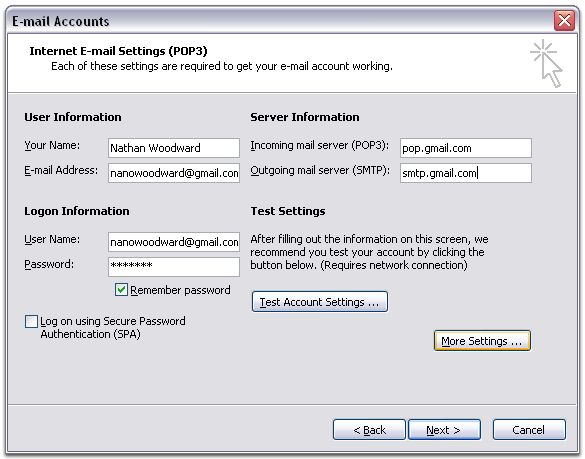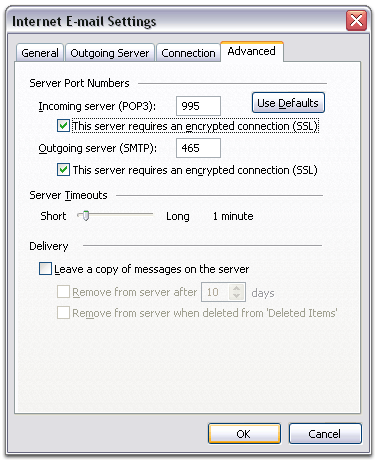E-mail configuration for outlook 2003
Below are directions to set it up manually
To set up your Outlook client to work with Gmail:
- Enable POP in your email account. Don't forget to click Save Changes when you're done.
- Open Outlook.
- Click the Tools menu, and select E-mail Accounts...
- Click Add a new e-mail account, and click Next.
- Choose POP3 as your server type by clicking the radio button, and click Next.
- Fill in all necessary fields to include the following information:
User Information
Your Name: Enter your name as you would like it to appear in the From: field of outgoing messages.
Email Address: Enter your full email address (username@gmail.com or username@your_domain.com)Server Information
Google Apps users, enter the server names provided, don't add your domain name in this step.
Incoming mail server (POP3): pop.gmail.com
Outgoing mail server (SMTP): smtp.gmail.comLogin Information
User Name: Enter your Gmail username (including @gmail.com). Google Apps users, enter your full address in the format username@your_domain.com
Password: Enter your email password

- Click More Settings... and then click the Outgoing Server tab.
-
Check the box next to My outgoing server (SMTP) requires
authentication and select Use same
settings as my incoming mail server.

-
Click the Advanced tab, and check the box
next to This server requires an encrypted connection
(SSL) under Incoming Server
(POP3).

- Check the box next to This server requires an encrypted connection (SSL) under Outgoing Server (SMTP), and enter 465 in the Outgoing server (SMTP) box.
- Click OK.
- Click Test Account Settings... After receiving Congratulations! All tests completed successfully, click Close.
- Click Next, and then click Finish.
- Download the latest updates for Outlook from Microsoft. This will help prevent the most common Outlook errors Gmail users see.
Congratulations! You're done configuring your client to send and retrieve Gmail messages.
Related Articles
- How to reach the right audiences, Focus your website content to the right direction
- Features a website most have, interactivity and improvements for your business.
- Understanding and analyzing the Bounce Rate of your websites.
- Online Payment Processing And Payment Gateways
- Help with websites infected with viruses.


 August, 2011
August, 2011
